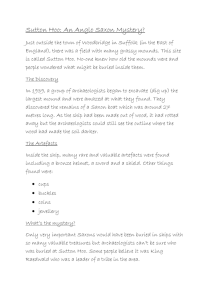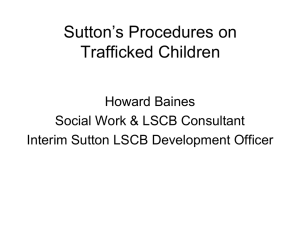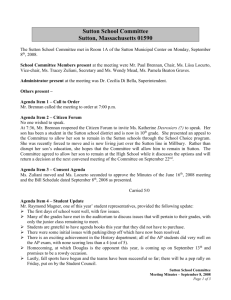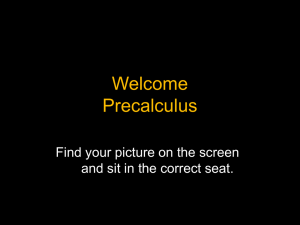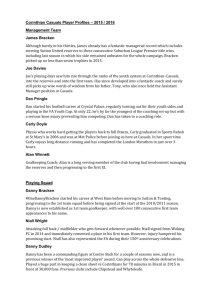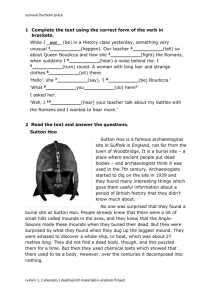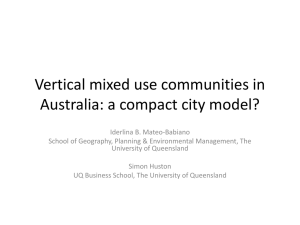SuttonSeniorBuilding
advertisement
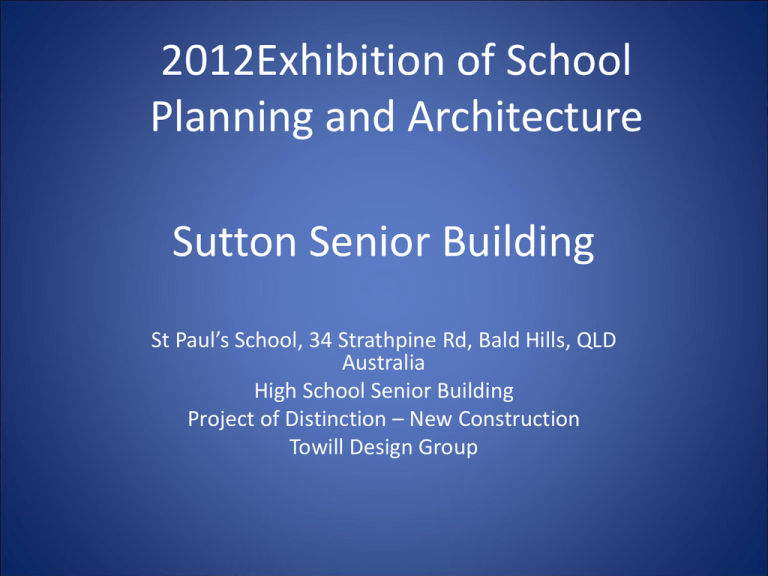
2012Exhibition of School Planning and Architecture Sutton Senior Building St Paul’s School, 34 Strathpine Rd, Bald Hills, QLD Australia High School Senior Building Project of Distinction – New Construction Towill Design Group Sutton Senior Building Main Exterior Image SOUTHERN ELEVATION Sutton Senior Building SITE PLAN Southern Elevation Community Environment The Sutton Senior Building was designed to replace two one storey 1960’s weather board buildings which were both scheduled for demolition under the School’s Master Plan. The original Sutton building accommodated Students Services including counselling with the location not favourable with staff as well as students. Therefore a building located in heart of the school was refurbished with a purposely designed facility. The new Senior Building also replaced another aging building which accommodated English, history and geography - this building also contained asbestos therefore no materials could be salvaged. The Sutton building opens to address the Senior Courtyard which was previously used as a thoroughfare due to the lack of landscaping and seating. The landscaping for the Senior Building has now revitalised the existing Courtyard, providing additional trees and communal tables for the senior students as well as reinstating a strong axial pathway connection past the Senior Building down to the Junior School, making the new Sutton building at an integral location of the college as students pass it to both the senior and junior school. The schools flag pole has now been relocated to this courtyard to enable national services such as ANZAC day ceremonies, proudly flying the nation’s flag in a prominent position. Café + Communal Space Community Environment: Continued… One significant part of the design brief was to include an area for the school community, families, staff and senior students to gather informally, therefore the design of a cafe was created. The cafe is run by the Parents Association and provides an area for parents to meet, as well as staff with parents to speak informally and senior students to socialise with one another. The cafe also has the ability to be used for the hospitality students to serve patrons and develop students skills within a realistic environment. The cafe services a large covered outdoor deck which complements the sub tropical Brisbane climate and receives good air flow from the north east. This area not only provides seating for customers but also provides a meeting area for many school community committees instead of a meeting room within a building. Music students also perform in the covered outdoor area with the inclusion of power and lighting to practice their performance skills to audiences. The whole building has been designed to encourage access by students, parents and visitors by providing good visual access internally and externally, and providing a destination for creating a closer school community. Senior Classroom Learning Environment: The architects held extensive workshopping with senior staff, discussing and challenging the evolving teaching & learning methods used within the school. It was important that the design of classrooms reflected spaces used in tertiary education; resulting in a combination of flexible arrangements (four of the ten classrooms can be merged together through operable walls), providing smaller ‘break out’ areas for smaller group activities, and a lecture theatre styled learning environment for up to 50 students, providing the students with a presentation platform similar to rooms at universities. The Sutton Senior Building houses: •Ten learning areas (including a mini lecture room), •Break out learning zones, •International school reception, •Staff workshops, •Hospitality teaching space •Cafe & external seating area The design brief was to reflect the staffs teaching methodology; in the workshop sessions, the design team challenged the traditional ‘single desks in rows with front of room delivery’. Different design scenarios and questionnaires were provided to the staff which developed discussions on how the traditional learning environment can change. There was initial reluctance from staff to think how they could deliver information in different methods. Classroom + Ground Floor Corridor Learning Environment: But by accommodating their concerns with design solutions, staff began to realise they had a ‘Voice’ and we were listening. Areas of concerns were challenging as design solutions were tested to address more than one issue. For example, the visual access from large learning spaces to small group areas provided supervision that staff required but also provided natural light into these areas. Not only were various room sizes and orientation created for various subjects, but also furniture layouts were equally as important. The design team tempted teaching staff with large round tables for discussions, smaller tables for groups of one or two and tables that can be broken into different sizes. The feedback from students has been positive - the differing layouts has changed their learning experience, the environment provides more independence than experienced in middle school and therefore an increased level of maturity. The Students involvement within the design was crucial to the buildings success and design team workshopped with students to discover who inspired them as a group and as individuals, incorporating stories into a graphics strip which runs through the building under the Schools motto ‘Create your own story’. This enabled the students to make a mark on their building and therefore created respect for their teaching environment. First Floor Corridor Physical Environment The Sutton Building has been designed with a strong responsibility to the environment. It aims to reduce maintenance costs and energy use but importantly provides a safe environment for staff & students. The building minimises excavation by following the natural contours, uses steel faced sandwich panels providing a high insulation value for the walls and roof, reverse brick veneer is used for the upper floor to reduce fluctuation in temperatures and robust materials have been selected for the building perimeter to reduce maintenance. The Senior Building responds to its neighbours through its scale and uses materials in a modern manner (such as the playful coloured brick façade, use of corrugated metal & recycled timber cladding) to tie in existing buildings in the school. The landscape architect designed the new landscaping, new senior courtyard & connecting pathways to reinstate a stronger axial connection between junior and senior school. Senior Classroom Physical Environment – Continued Environmental Considerations: Floors: exposed concrete with 30% Fly Ash and sealed in water based sealer Walls: Double masonry to the ground floor and reverse brick veneer to the upper floor Roof & Sun Shading & Southern Facade: Steel faced sandwich panel R.5.35 Ceiling: Fixed hoop pine panels serve as cable trays for services & provide acoustics treatment Windows: Comfort Plus Glazing (Low Emission Glazing) Building Management System (BMS): controls windows, louvers & air conditioning via a weather station. The BMS has the ability to collect data for water and energy usage & can be used a learning tool for students & teachers. Natural Ventilation: through operable windows & louvers, connected back to the BMS. Water Harvesting & Reuse: collected by rain water tanks for toilet flushing & irrigation. Dematerialisation: avoids excessive layering by exposing materials & limiting finishes. This expressive nature makes the building a sustainable learning tool for students, staff and parents. Material Selection: materials robust in nature & assessed by their content & location, also ensuring the products, materials & adhesives are not harmful to growing children and staff. Energy: Solar Hot Water System & PV panels 7KW system to be installed in 2012 Corridor + Break Out Space Planning Process: Narrative Principal’s Brief: “To design a teaching facility that embraces the concept of 21st century learning and meets the needs of the International School within the budget” Paul Browning Headmaster To compile a return brief, Towill Design Group – director Rachel Towill and architect Louise Booth conducted staff workshops and reviewed the master plan to establish the following facilities were required: •2x teachers work rooms •Beverage production workshop •International School reception •4 x International classrooms •7 x General purpose classrooms •Toilet facilities •Storage •3x Break out teaching spaces •Cafe with Covered outdoor area with access to the library The design team workshopped with staff to understand their needs for teaching and learning, and the building itself. These workshops also created discussions for developing new teaching and learning methodologies. The school team leaders were Donna Wright, Julie Bryce, Debbie Hansen and Chris Jimmieson. External Materials Planning Process: Continued Staff feedback collected from workshops included: •Senior classes involve a combination of individual work and group work •Furniture should be flexible to be able to be moved when teaching styles change •The idea of ‘team teaching’ could be introduced through the use of stack doors where two classes combine as one •Natural light, natural ventilation and colour is needed in classrooms •Visibility is very important – teachers need to be able to see students outside of classroom areas •Breakout spaces can be used by students for individual research The environmental design decisions were discussed with the staff and school council so they could understand how the building will look and operate and of course why. It was identified that natural ventilation was essential. A heightened corridor space on the First Floor with high level louvers allows hot air to escape the building. An automatic controlled window & louver system on a BMS (Building Management System) control allows staff to teach without the need to alter their environment to suit climatic conditions – this also helps reduce power usage. Large ceiling fans provide for air movement, which can allow occupants to tolerate small increases in temperatures before air conditioning is required. Timeframe: The collaborative workshops were held in April 2010 with final sketch plans completed by end of July 2010. The project went to tender in November 2010, with construction beginning March 2011 and completed in December 2011. IMAGE Ground Floor plan First Floor plan Exhibition of School Planning and Architecture Project Data Submitting Firm : Project Role Project Contact Title Address City, State or Province, Country Phone Towill Design Group Architect – Principal Consultant Rachel Towill Director PO Box 693 New Farm QLD 4005 Brisbane, Queensland, AUSTRALIA +61 738523013 Other Firm: Project Role Project Contact Title Address City, State or Province, Country Phone Woods & Grieve Engineers Electrical, Mechanical & Civil Design Andrew Bell Mechanical Manager Level 2, 15 Leichhardt Street, Spring Hill QLD4000 Brisbane +617 3811 4500 Other Firm: Project Role Project Contact Title Address City, State or Province, Country Phone AWT Consulting Engineers Structural Engineer Alan Tingcombe Senior Structural Engineer UNIT 17, LEVEL 2, 18 BRINDABELLA CCT BRINDABELLA BUSINESS PARK CANBERRA INTERNATIONAL AIRPORT ACT 2609 +612 6257 2614 Construction Firm: Project Role Project Contact Title Address City, State or Province, Country Phone DGW Group Principal Contractor Darrel Boss Site Foreman PO Box 341, Wilston Q 4051 Brisbane, Queensland, AUSTRALIA +617 3356 5911 Exhibition of School Planning and Architecture Project Details Project Name Sutton Senior Building City Brisbane, Australia State Queensland District Name Bald Hills Supt/President Principal = Mr Paul Browning Occupancy Date January 2012 Grades Housed Senior Students (Grades 11 & 12) Capacity(Students) Site Size (acres) 325 students (110 on Ground Floor, 225 on First Floor) 0.64 acres (immediate landscaped site only, not entire school site) Gross Area (sq. ft.) 18083 sq ft Per Occupant(pupil) 55 sq ft per student gross/net please indicate Gross (note - excludes any landscaped/decking areas) Design and Build? Yes If yes, Total Cost: $4.7 million Design & Documentation Fees, Landscaping, Fixtures & Fittings, Loose Furniture, Solar Panels, Physical Building. Includes: If no, Site Development: Building Construction: Fixed Equipment: Other: Total: $4.7 million Supporting/Supplemental files/Images MINI LECTURE ROOM STAIRWAY CONNECTING LEVELS WITH GRAPHICS SELECTED BY STUDENTS Supporting/Supplemental files/Images HOSPITALITY TEACHING AREA CAFÉ CONNECTED TO DECK & HOSPITALITY TEACHING AREA Supporting/Supplemental files/Images MAIN ENTRY FROM SENIOR COURTYARD BREAKOUT STUDY AREA IN CORRIDOR UPSTAIRS Supporting/Supplemental files/Images SENIOR CLASSROOM ON GROUND FLOOR LARGE NORTHERN FACING OUTDOOR DECK, CONNECTED TO CAFÉ & CLASSROOMS Supporting/Supplemental files/Images NORTHERN ELEVATION SOUTHERN ELEVATION SKETCH SECTION OF VENTILATION SENIOR CLASSROOM WITH COLOURED JOINERY AND EXPRESSED STRUCTURE

